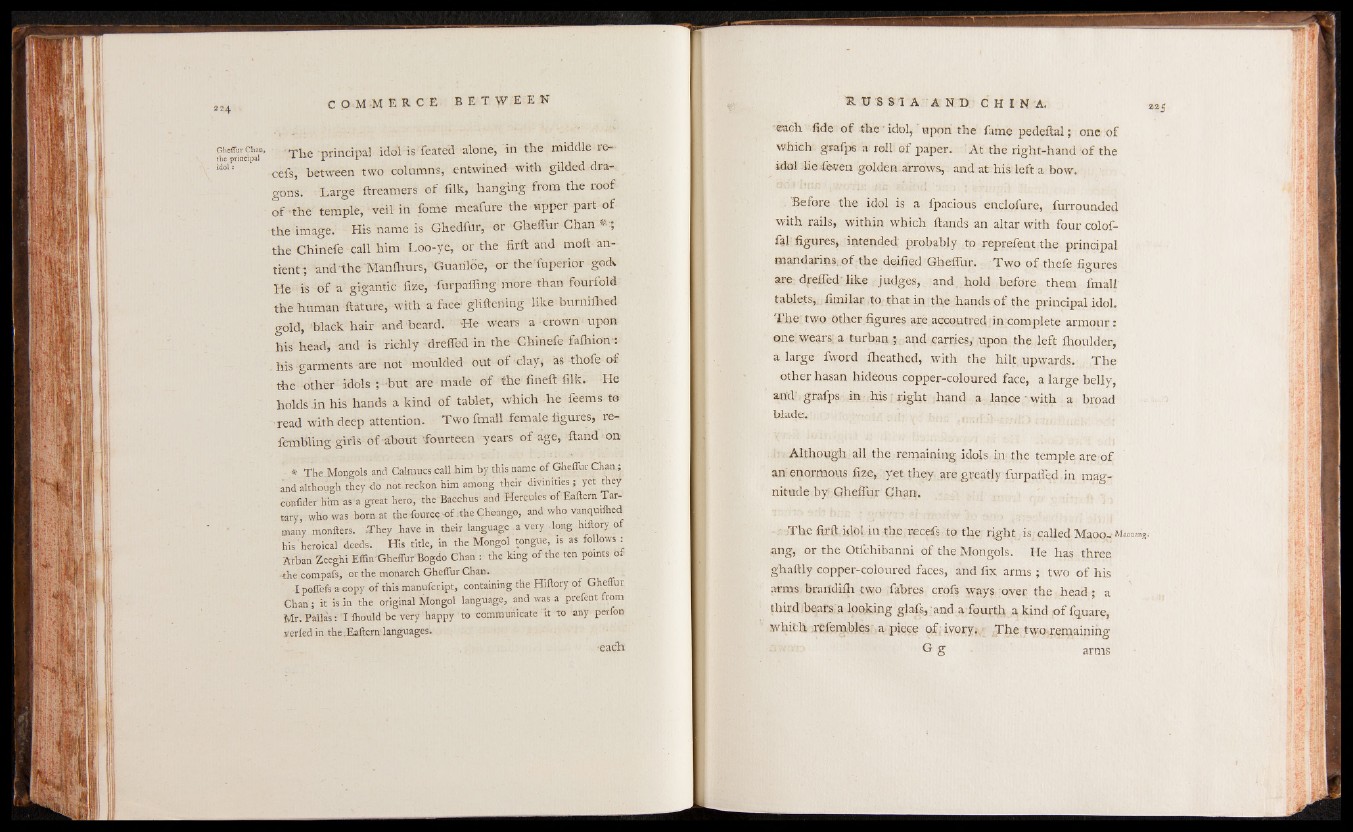
Gheffur Clian,
the principal
idol •
The principal idol is Teated alone, in the middle re-
cefs, between two columns, entwined with gilded drar-
gons. Large ftreamers of filk, hanging from the roof
of the temple, veil in fome meafure the upper part of
the image. His name is Ghedfur, or Gheffur Chan P?
the Chirtefe -call him Loo-ye, or the firft and molt an-
tient; and 'the Manflrurs, Guanloe, or the'fuperior godv
He is of a gigantic fize, furpaffing more than fourfold
the human ftature, with a face- gliftening like burmfhed
gold, ‘black hair and heard. 'He wears a crown upon
his head, and is richly dreffed in the Chinefe falhion r
his-garments are not moulded out of'day, as thole of
the other idols ; but are made of the fineft filk. He
holds .in his hands a kind of tablet, which he feems ta
read with deep attention. Two fmall female figures, re-
fembling girls of about ‘fourteen Tears of age, ftand on *
* The.Mongols and Calmucs call i im by this name o f Gheffur Chan.;,
and although they-do not. reckon him among their divinities ; yet they
confider hhn as'a great hero, the Bacchus' and Hercules'ofEaftern Tartary,
who was born at the fouree o f rthe Choango, and who vanquilhed
many monfters. T h e y have in their language a very , long hiftory. of
his heroical deeds. His title, in the Mongol tongue, is as follows :
Arban Zeeghi Effm'Gheffur Bogdo Chan : the king o f the ten points o f
the compafs, or the monarch Gheffur Chan.
I poffefs a copy o f this manufcript, containing the Hiftory o f Gheffur.
Chan; it is in the original Mongol language, and was a prefent from
Mr. Pallas: I ihould be very happy to communicate :it to any perfon
yerled in the .Eaftern languages.
-each
®ach fide of the idol, upon the fame pedeftal; one of
which grafps a roll of paper. At the right-hand of the
idol lie fe-ven golden arrows, and at his left a bow.
Before the idol is a fpacious enclofure, furrounded
with rails, within which Hands an altar with four colof-
l'al figures, intended probably to reprefent the principal
mandarins.of the deified Gheffur. Two of thefe figures
are drefled like judges, and hold before them fmall
tablets,,, fimilar to that in the hands of the principal idol.
The two other figures are accoutred in complete armour :
one wears; a turban and carries,- upon the left ihoulder,
a large fword fheathed, with the hilt upwards. The
other hasan hideous copper-coloured face, a large belly,
and' .grafps in his; right hand a lance with a broad
blade.
Although all the remaining idols in the temple are of
an enormous fize, yet th^y are greatly furpaffed in magnitude
by Gheflur Chap.
■ .The firft;idol in the recefs to the right fis;called Maoo-Maoo.™g.
ang, or the Otfchibanni of the Mongols. He has three
ghaftly copper-coloured faces, and fix arms ; two of his
arms bratfdifli two fabres crofs ways over the head ; a
third bears a looking glafis, and a fourth a, kind of fquare,
whith rcfembles a piece of ivory,,- The, two remainihg
G g - arms